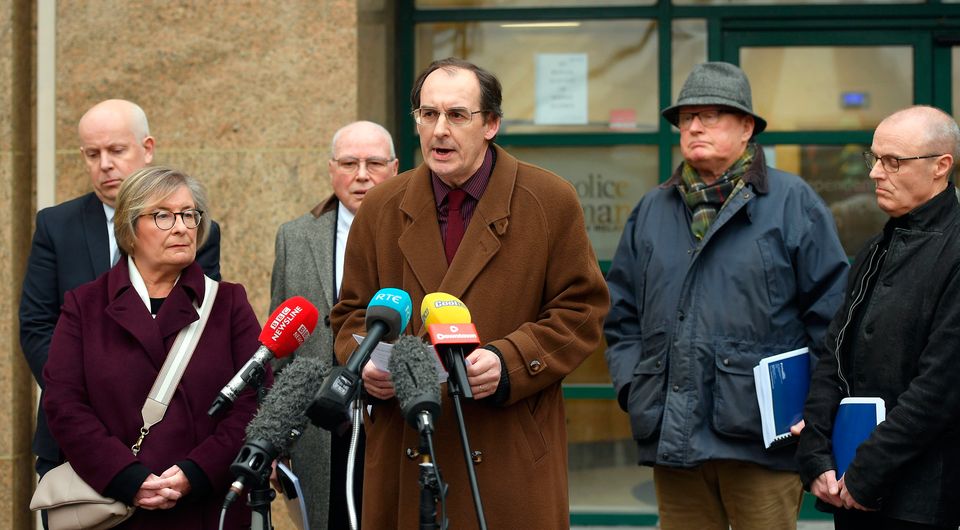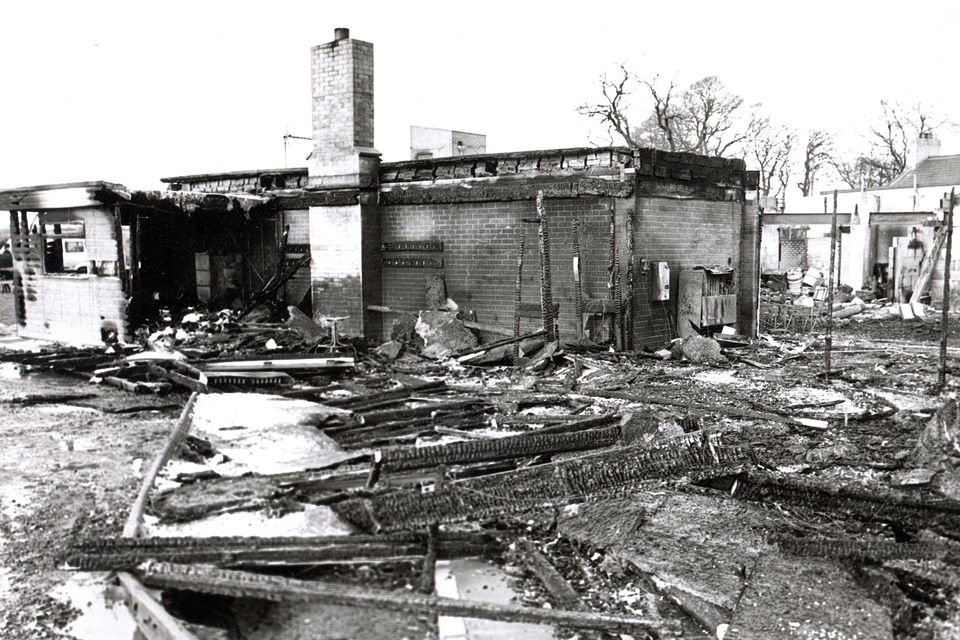There was no evidence of police collusion in the original investigation into the 1978 La Mon House Hotel bombing, a report from the Police Ombudsman has said.
The report also said there had been an “earnest endeavour” to bring those responsible to justice.
Twelve people were killed and scores injured in the atrocity when the Provisional IRA exploded a bomb at the hotel on the outskirts of Belfast in 1978.
Survivors of the attack and family members of some of those who died have said they will continue with their campaign to find out the identities of those responsible.
Families, friends, and campaigners outside the office of the Police Ombudsman for Northern Ireland in Belfast. Image: Oliver McVeigh/PA Wire
Delivering a long awaited report, the Police Ombudsman said that despite concerns that informants may have been involved in the bombing, “collusive behaviours” were not a feature of the Royal Ulster Constabulary (RUC) investigation.
Senior director of investigations with the Police Ombudsman’s office, Paul Holmes, said investigators did not find evidence or intelligence that would support the suggestion of malpractice by police officers and found no intelligence which could have forewarned of, or prevented, the bombing.
He said: “The substantial police investigation files, associated documentation and intelligence records reviewed by this office, together with explanatory accounts from a number of former police officers and other inquiries, lead me to conclude that there was earnest endeavour by the RUC to bring those responsible for the bombing of La Mon House to justice.
“However, maintenance of the investigation did not have the same rigour and this manifested in the loss of investigative material and the failure to interview the person arrested in 1991 in relation to the bombing.
“I am of the view, based on all available evidence and information, that collusive behaviours were not a feature of this RUC investigation.
“The evidence and intelligence viewed by the Police Ombudsman’s investigation attributes responsibility for directing, enabling and perpetrating the bombing of La Mon House to the Provisional IRA,” Mr Holmes concluded.
The ombudsman’s report, published on Wednesday, considered the effectiveness of the RUC investigation, including the resulting prosecutions against two men.
One of the men was convicted of 12 counts of manslaughter in 1981, while the other was acquitted during his trial in 1980 after he alleged he had been assaulted by police while in custody.
Read more
At the 1980 trial, the judge said he could not be satisfied beyond reasonable doubt that the man’s statements had not been “adduced by torture or inhuman or degrading treatment” and the statements were excluded.
The case was dismissed in the absence of other evidence.
Mr Holmes said the judge’s comments and trial outcome pointed to “a violation of the rule of law by the police officers involved”.
He also said a loss of records and exhibits from the original investigation was “frustrating” and affected investigators ability to properly assess the RUC’s response.
Mr Holmes said: “My ability to provide a definitive view on the effectiveness of the RUC investigation, including whether all appropriate lines of inquiry were pursued, has been hindered by the unavailability of certain documentation generated by the investigation.
“It has not been possible to establish the circumstances in which these records were lost. However, this is a recurring, systemic issue in legacy cases and is not unique to this investigation.”
Ombudsman investigators said they could access the majority of records generated by the RUC investigation and concluded the initial response to the attack was prompt and well managed.
“The first police officers to attend the scene displayed courage and professionalism in seeking to save lives and tend to the injured,” said Mr Holmes.
“More than 100 detectives were involved in the murder investigation and almost 400 statements were recorded. Scenes were identified and exhibits seized, and forensic examinations took place.
“In the context of the significant pressures and challenges faced by the RUC at that time, I am of the view that the investigation was well resourced and received direction from the highest levels of the RUC.”
Axel Schmidt, UHRW Advocacy Service Manager, speaks to the media along with families, friends, and campaigners outside the office of the Police Ombudsman for Northern Ireland. Image: Oliver McVeigh/PA Wire
A number of bereaved families were briefed on the outcome of the report at the ombudsman’s office on Wednesday morning.
They were joined by Axel Schmidt, advocacy manager at Ulster Human Rights Watch, who said it had been “a long and challenging road for the victims and relatives of one of the worst terrorist atrocities of the Troubles”.
He added: “It has taken 46 years to get to this point. We know what happened, but questions remain to this day.”
Mr Schmidt said the families had asked the ombudsman to provide them with the identities of the bombmakers and the IRA leaders who sanctioned it.
He said: “Sadly, the ombudsman, for security reasons, was unable to make available all the security intelligence.
“It is important to note that the investigation carried out by the police ombudsman did not reveal any collusion between the terrorists and any branch of the Royal Ulster Constabulary.
“The people here today are satisfied with that outcome.
“This campaign for answers and some measure of justice will go on.
“Our next step will be to lodge a request with the Independent Commission for Reconciliation and Information Recovery to ascertain who were the people responsible for the bombing and the role the Republic of Ireland played in allowing terrorists to make the bomb and provide protection from arrest and prosecution while residing in its territory.”
Firemen searching through the rubble at the wrecked La Mon House restaurant near Belfast (PA Archive)
The PSNI said in a statement it is aware of the “hurt and anger” of the families affected by the La Mon atrocity.
Assistant Chief Constable Ryan Henderson, of the Justice branch, said the organisation’s thoughts are with the families and friends of those killed and injured in the “cowardly attack on innocent people socialising on a night out”.
“We are very aware of the hurt and anger still being felt by the families of all those who were affected by this indiscriminate bomb attack and we extend our sincere sympathies to all those families,” he said.
“We acknowledge the historic issues identified in the report concerning records management in this investigation, however, this was at a time that predated the introduction of the computerised Home Office Large Major Enquiry System (Holmes).
“While the Police Ombudsman’s report has identified some investigative failings, it also highlights that the investigation was well-resourced, comprehensive and effective.
“The report has found that police held no intelligence prior to the attack that could have prevented it and also found that there was no evidence that any persons were protected from prosecution.
“I would also like to reflect on the courage, compassion and professionalism and of the police officers who responded to the scene of the bombing.
“The difficult and challenging circumstances they faced when dealing with the victims and survivors represented the highest of standards and I welcome the fact that the Police Ombudsman has highlighted this in the report.”
News Catch Up: Wednesday 11th December



